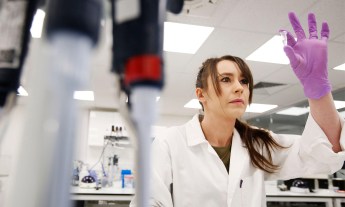
Imagine being 38 years old, healthy, a nonsmoker with no pre-existing health conditions, and then waking up one morning feeling like you were being suffocated by an unseen force.
In March of 2020, that was my reality.
Ten days after returning from a trip to Europe, I started having flu-like symptoms. I became weak overnight and had trouble breathing. It felt like jogging in the Rocky Mountains without being in condition — only I wasn’t moving.
I went to the hospital, where I was tested for COVID-19. In those early days of the pandemic, I was one of the first people in Texas who was given a non-FDA-approved COVID test, and my results came back negative.
I’m part of a growing group of people who’ve had COVID and never fully recovered, a condition thought to affect between 30%-60% percent of those infected with COVID.
As a social epidemiologist who deals with big data and knew that COVID cases were on the rise, I was certain it was a false negative. The test itself even carried a warning that false negatives were possible and that clinical observations and patient history should be taken into consideration. But I was sent home, and by the end of March 2020, I thought I was on the road to recovery.
Then, in April, I had a seizure and was rushed to the hospital. At the ER, the doctor reviewed my medical case history and concluded that I had COVID. She said that I was lucky and tests showed my organs did not have lasting damage.
But after the seizure, I lay in my bedroom for weeks with the curtains drawn, because light and sound hurt. I started suffering from tremors, extreme migraine headaches, a feeling that I was walking on rocks, and a pins-and-needles sensation that radiated through my body. There were times that I needed a cane to help me walk, and I knew something was seriously wrong with me.
Fatigue is one of the most common persistent symptoms, but there are many others, including tissue damage in the lungs, extreme exhaustion after daily tasks, and brain fog.
It was not until months later that I discovered I was a long-hauler — part of a growing group of people who have COVID-19 and have never fully recovered. Later, we would be given an official name of Post-Acute Sequelae of SARS-CoV-2 infection (PASC), which is estimated to affect between 30 percent and 60 percent of people who become infected with COVID-19.
The US Centers for Disease Control states that post-COVID conditions can appear four or more weeks after initial infection. Fatigue is one of the most common persistent symptoms of people who suffer from long COVID, but there are many others, including pulmonary fibrosis (tissue damage in the lungs), post-exertional malaise (extreme exhaustion after gentle exercise or daily tasks), and brain fog or debilitating cognitive effects.
Four months after my initial symptoms in March 2020, my heart still raced even though I was resting. I could not stay in the sun for long periods; it zapped all of my energy. I had gastrointestinal problems, a sore throat, extreme fatigue, ringing in my ears and chest pain.
I have felt like a guinea pig this past year, with doctors not knowing what to give me for treatment.
Treatment options for long COVID are not robust, and they’re mainly geared towards treating the symptoms, organ by organ with anti-inflammatories for the lungs, beta blockers for a racing heart rate, etc. Although some innovative options are being explored, their use for long COVID remains unproven until they are studied more widely.
I have felt like a guinea pig this past year, with doctors not knowing what to give me for treatment. In the beginning, I was given an inhaler and topical medicine to treat my pain. Then I was put on a steroid inhaler that made me sicker. My own treatment focus has been geared towards taking a multitude of supplements.
This journey has been a nightmare for me, not only because of having to deal with a life-threatening illness but also because I belong to a large group of people who had a negative COVID test or could not get tested at the start of the pandemic. Recent research shows that as few as 1 to 3 in 100 cases of COVID were being detected in early 2020. Many of us have struggled to be believed by doctors. This is a noticeable pattern for women, and in particular women of color, which led me to launch an online support group for women of color from around the world.
A common frustration is that some medical doctors dismiss our complaints as psychological. One woman in the support group writes: “140 days later, so many are hard to breathe, and no doctors will take me seriously as I was diagnosed with a negative swab and negative antibodies.” Another woman writes she feels that she’s been left drowning by doctors.
In June 2021, the CDC advised doctors to focus less on tests and more on patient history to diagnose long COVID. This was a big win.
When presenting at the emergency room, many women of color in the support group have reported that doctors assumed they were experiencing a drug overdose and drug-tested them before care was given. The fact that this happened to so many women in different states across America highlights a public health need to address the biases doctors bring to the treatment room.
People with chronic diseases have reported the same pattern of not being believed. I knew these alarming statistics before I got sick, but as a health researcher with the knowledge I needed to advocate for myself, I didn’t think I would get the same treatment I had read about. Thankfully, the CDC released updated guidelines in June 2021, advising doctors to focus less on COVID tests and more on patient history to diagnose long COVID patients. This was a big win for the long COVID community.
Today, it has been 20 months since I initially became sick and I am still not 100 percent. I experience slight progress each month, and I am not in the same debilitating condition that I was at six months.
Month 12 is when I felt my body transitioning into a new phase. My nightly hot flashes began to subside, and I was able to sleep without running the air conditioner on max. At that point, I started describing myself as functional.
Now I have good days and bad days. Symptoms that remain constant for me, even on a good day, include chronic fatigue, post–exertional malaise, chest pain, elevated body temperature, skin rash and headaches. On some days, my sore throat and the ringing in my ears are painfully noticeable, and on other days they feel slightly in the background.
My menstrual cycle triggers monthly flare-ups when I get excruciating headaches, gastrointestinal problems and dizziness and am typically bedridden for at least two days.
My menstrual cycle triggers monthly flare-ups when I get excruciating headaches, gastrointestinal problems, dizziness — to name a few symptoms — and am typically bedridden for at least two days. At the same time, neurological symptoms that were once prominent, including the sensation of feeling like I was walking on rocks, pins and needles shooting throughout my body, and brain fog are not as big of a problem today as they were last year.
It’s still unclear why COVID impacts some people more severely than others — but what we do know is that anyone can get long COVID. On July 31, 2020, the CDC acknowledged that young adults with no prior medical issues can experience these long-term symptoms.
It’s been over a year since that CDC report was published, and we now know that in addition to young adults, about half of children aged 6 to 16 who contract COVID will develop long-term COVID symptoms. (This is separate from the children who struggled with MIS-C — a syndrome that can cause different parts of the body, like the heart, kidneys, lungs or gastrointestinal organs to become inflamed — after an initial COVID infection.)
Scientists expect that COVID-19 will be endemic, that it will continue to circulate in the way other diseases like influenza do rather than being eradicated outright like smallpox. Given this, we should be just as aggressive in researching treatment options as we are with developing vaccines. Unfortunately, most of the known clinical trials are focused on treating the initial phase of COVID infection and not on the prolonged aftermath that I and many other people are experiencing.
Long COVID patients are counting on you to get vaccinated and help slow the spread of COVID, so we can venture out in public without fear.
I am not alone in feeling that long COVID is a profoundly hellish experience. Reports highlight that some people with long COVID have been dying by suicide because of their pain. It is possible COVID is neurotoxic, causing changes to the normal operation of the body’s nervous system, which might explain why many people like me have painful neurological problems. Almost all people with long COVID are experiencing symptoms similar to mononucleosis and myalgic encephalomyelitis/chronic fatigue syndrome.
If your loved one has long COVID, it is important that you support them on their journey by helping them maintain a positive mindset. Try to bring them joy, not stress.
And please: Never visit them if you are sick. You might have a minor cold, but for someone who has long COVID, catching your cold could land them on bedrest for weeks.
It is also important that you do not advise your loved one suffering from long COVID to try different treatment options or to engage in more physical activity. Know that if they could do it, they would; many people struck down by long COVID were previously very active.
For now, the most important thing you can do to support someone with long COVID is get vaccinated and follow public health guidance. Long COVID patients are counting on you to help slow the spread of COVID, so we can venture out in public without fear.
No doctor can give me a pill that will make my illness go away. I look absolutely fine, but I wake up every day in pain.
Despite being left chronically ill since getting COVID, I make an effort each day to seize the day. There are a limited number of things I can do, and it is my goal to identify my daily activity and lean into it. The feeling of accomplishing something, no matter how small, gives me hope that I am becoming healthier.
I am learning to manage living with long COVID. This means healthy eating, pacing myself, and incorporating lifestyle tips from people who struggled — even before the COVID-19 pandemic — with myalgic encephalomyelitis/chronic fatigue syndrome (ME/CFS).
The hardest part of this journey is accepting that I now have an invisible disability. As of July 2021, long COVID is considered a disability under the Americans with Disabilities Act (ADA). No doctor can tell me how long it will last and no doctor can give me a pill that will make my illness go away. I look absolutely fine, but I wake up every day in pain.
The small milestones in my life are what I cherish most. I cannot wait until the day comes that I wake up and this illness is gone from my body.
Watch Dr. Margot Gage Witvliet‘s TEDxMileHigh Talk here:















